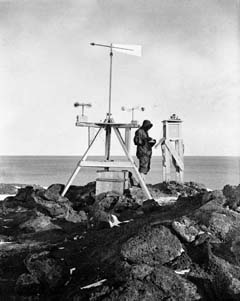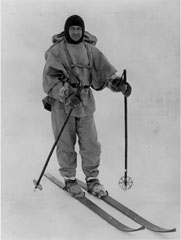
Yale University Press August 2001
Then - The expedition meteorologist was Dr. George C. Simpson. Here Simpson is shown taking data at his weather station -- one of the first on the continent. Simpson meticulously analyzed the expedition's weather data, and frequently shared his insights with Scott.
Now - A modern automated weather station. Data are typically obtained every 10 minutes and are transmitted in real-time to a satellite, from which they are relayed back to a ground station outside Antarctica. The data are archived on the Internet by a research team at the University of Wisconsin, Madison: Antarctic automatic weather station project.
In this map of Antarctica and the Ross Ice Shelf, the expanded view of the Barrier shows Ross Island, Scott's route for his 1911-12 trek, and the contemporary weather stations that now lie along his path. One weather station lies just 30 miles from the spot where Scott, Wilson, and Bowers camped for the last time in March, 1912. These mechanical sentinels have provided years of data that now demonstrate the terrible challenge that unusual weather posed for Scott and his companions.

"....no one in the world would have expected the temperatures and surfaces which we have encountered at this time of the year....It is clear that these circumstances come on very suddenly, and our wreck is certainly due to this sudden advent of severe weather, which does not seem to have any satisfactory cause." -Robert Falcon Scott's Message to [the] Public, March, 1912
Scott and his men carefully probed the weather of the Antarctic, and their "forecast" of what to expect was remarkably accurate. But the conditions they experienced on their return from the Pole were very far from normal. The daily minimum temperatures they endured in late February and March in 1912 were near -40ºF at a time of year when -20 to -25ºF is typical.
Those chilling temperatures had a devastating effect on the rates of progress of Scott and his companions as they returned across the Ross Ice Shelf. Scott's party progressed well at first in typical Antarctic summer weather. But as the temperatures plunged, their speeds became slower and slower compared to those of two supporting parties who returned only a few weeks earlier - including one shorthanded group of three that included a sick man. The unusually cold conditions had crippling effects not only in terms of frostbite, but also in the friction of the frigid snow that gripped at their skis and sledge runners "like....desert sand, not the least glide in the world" (-R. Scott, Scott's Last Expedition). Pictured is Captain Scott on skis. Photograph by H. Ponting. Scott Polar Research Institute, Cambridge.
Useful internet resources: